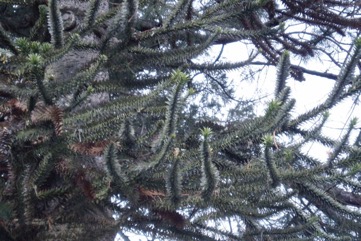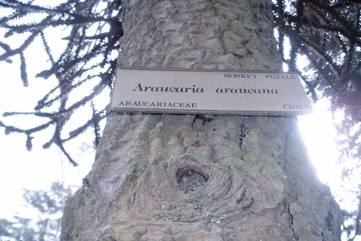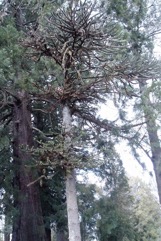Monkey Puzzle Tree, Chilean pine

It is a temperate plant. It grows in sub-antarctic regions. It grows naturally in cool moist coastal and upland regions of Chile and Argentina. In Argentina it grows between 600-1,700 m above sea level. It can tolerate drought conditions. They need a well drained soil. It does best with cool misty summers. It can tolerate frost to -20°C. It suits hardiness zones 7-9. West Takone. Kyneton Botanical Gardens. Arboretum Tasmania.
Also known as:
Chile nuts, Nguilliu, Pehuen, Pino araucaria, Pinon
Synonyms
- Araucaria imbricata Pav.
- Araucaria chilensis Mirb.
- Araucaria dombeyi A. Rich.
- and others
Edible Portion
- Seeds
Where does Monkey Puzzle Tree grow?
Found in: Africa, Andes, Argentina, Australia, Brazil, Britain, Canada, Central America, Chile, Dominican Republic, East Africa, Europe, Hawaii, India, Ireland, Mozambique, North America, Panama, South America, Tasmania, United States
Notes: There are 19 Araucaria species. There are 13 species in New Caledonia.
Status: Seeds are enjoyed in Chile. Estimates are that 3,400 tons of seeds are harvested for eating in Brazil.
Growing Monkey Puzzle Tree, Chilean pine
Cultivation: Plants are grown from seed. The temperature needs to be above 20°C. They can also be grown from sprouts from stumps. It is necessary to have trees of both sexes for fruit to form.
Edible Uses: The seeds are boiled or roasted and eaten. They are also eaten raw. They are also used to make an alcoholic drink. Caution: Alcohol is a cause of cancer.
Production: Trees take 40 years until first nuts are produced.
Nutrition Info
per 100g edible portion| Edible Part | Energy (kcal) | Protein (g) | Iron (mg) | Vitamin A (ug) | Vitamin c (mg) | Zinc (mg) | % Water |
|---|---|---|---|---|---|---|---|
| Seed | - | - | - | - | - | - |
Monkey Puzzle Tree, Chilean pine Photos



References
Ambasta S.P. (Ed.), 2000, The Useful Plants of India. CSIR India. p 49
Bircher, A. G. & Bircher, W. H., 2000, Encyclopedia of Fruit Trees and Edible Flowering Plants in Egypt and the Subtropics. AUC Press. p 37
Bodkin, F., 1991, Encyclopedia Botanica. Cornstalk publishing, p 95
Brickell, C. (Ed.), 1999, The Royal Horticultural Society A-Z Encyclopedia of Garden Plants. Convent Garden Books. p 130
Brouk, B., 1975, Plants Consumed by Man. Academic Press, London. p 208
Ciesla, W.M., 1998, Non-wood forest products from conifers. Non-wood forest products 12, FAO, Rome, p 81
Coombes, A.J., 2000, Trees. Dorling Kindersley Handbooks. p 34
Cordero, S. E., Abello, L. A., & Galvez, F. L., 2017, Plantas silvestres comestibles y medicinales de Chile y otras partes del mundo. CORMA p 35
Cundall, P., (ed.), 2004, Gardening Australia: flora: the gardener's bible. ABC Books. p 171
Daly, A. B., 20014, Narrating changing foodways: wild edible plant knowledge and traditional food systems in Mapuche lands of the Andean Temperate Forests, Chile. Masters Thesis Vancouver. p 45
Dendrologie 2(2):206. 1873
Etherington, K., & Imwold, D., (Eds), 2001, Botanica's Trees & Shrubs. The illustrated A-Z of over 8500 trees and shrubs. Random House, Australia. p 98
Facciola, S., 1998, Cornucopia 2: a Source Book of Edible Plants. Kampong Publications, p 26
Farrar, J.L., 1995, Trees of the Northern United States and Canada. Iowa State University press/Ames p 39
Flowerdew, B., 2000, Complete Fruit Book. Kyle Cathie Ltd., London. p 187, 209,
Glowinski, L., 1999, The Complete Book of Fruit Growing in Australia. Lothian. p 132
Gouldstone, S., 1983, Growing your own Food-bearing Plants in Australia. Macmillan p 154
Grandtner, M. M. & Chevrette, J., 2013, Dictionary of Trees, Volume 2: South America: Nomenclature, Taxonomy and Ecology. Academic Press p 41
Harris, E & J., 1983, Field Guide to the Trees and Shrubs of Britain. Reader's Digest. p 229
Hedrick, U.P., 1919, (Ed.), Sturtevant's edible plants of the world. p 67
Jackes, D. A., Edible Forest Gardens
Joyce, D., 1998, The Garden Plant Selector. Ryland, Peters and Small. p 166
Kiple, K.F. & Ornelas, K.C., (eds), 2000, The Cambridge World History of Food. CUP p 1891
Ladio, A. H. & Lozada, M., 2000, Edible Plant Use in a Mapuche Community of North-western Patagonia, Human Ecology. Vol. 28, No. 1. pp. 53-71
Ladio, A. H., 2001, The Maintenance of Wild Edible Plant Gatherings in a Mapuche Community of Patagonia. Economic Botany, Vol. 55, No. 2, pp. 243-254
Ladio, A. H. and Lozada, M., 2003, Comparison of wild edible plant diversity and foraging strategies in two aboriginal communities of northwestern Patagonia. Biodiversity and Conservation 12: 937–951
Ladio, A. H. and Lozada, M., 2004, Patterns of use and knowledge of wild edible plants in distinct ecological environments: a case study of a Mapuche community from northwestern Patagonia. Biodiversity and Conservation 13:1153-1173
Lamberton, K (Ed.), 2004, The Australian gardening encyclodepia. Murdoch Books, NSW Australia. p 173
Lord, E.E., & Willis, J.H., 1999, Shrubs and Trees for Australian gardens. Lothian. p 77
Lyle, S., 2006, Discovering fruit and nuts. Land Links. p 71
Marinelli, J. (Ed), 2004, Plant. DK. p 134
Menninger, E.A., 1977, Edible Nuts of the World. Horticultural Books. Florida p 158
Phillips, R. & Rix, M., 2002, The Botanical Garden Vol. 1. Trees and Shrubs. MacMillan. p 19
Plants for a Future database, The Field, Penpol, Lostwithiel, Cornwall, PL22 0NG, UK. http://www.scs.leeds.ac.uk/pfaf/
Rapoport, E. H. & Ladio, A. H., 1999, Plantas comestibles. Bosque Volume 20 No. 2. ISSN 0314-8799
Ryan, S., 2008, Dicksonia. Rare Plants Manual. Hyland House. p 64
Schuler, S., (Ed.), 1977, Simon & Schuster's Guide to Trees. Simon & Schuster. No. 7
Young, J., (Ed.), 2001, Botanica's Pocket Trees and Shrubs. Random House. p 98
Wickens, G.E., 1995, Edible Nuts. FAO Non-wood forest products. FAO, Rome. p173
World Checklist of Useful Plant Species 2020. Royal Botanic Gardens, Kew
www.chileflora.com